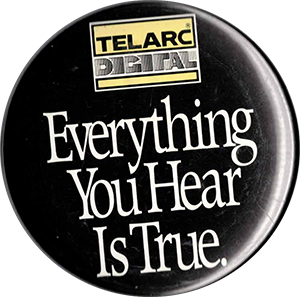Everything You Hear Is True: Introduction

On April 4, 1978 at Cleveland’s storied Severance Hall, pioneering wind ensemble conductor Frederick Fennell gave the downbeat for the first-ever digital recording session of a classical ensemble in the United States. The founders of Telarc Records, engineer Jack Renner and producer Bob Woods, guided Fennell and the musicians of the Cleveland Symphonic Winds through selections by Gustav Holst, Georg Frederic Handel, and J.S. Bach. Also in the control room were writers from leading audio magazines, invited there to witness this landmark event.1 The percussion section used Fennell’s personal bass drum mallet with the bass drum rotated to face the microphones for maximum musical impact.2 The recording they made would come to be known as “The Bass Drum Heard Round the World” and its historical significance was recognized in 2019 with induction into the National Recording Registry at the Library of Congress.3
In the three decades following this singular session, Telarc released over six hundred recordings, selling more than ten million copies and winning fifty-two Grammy awards. The choice of artists, the deployment of brand-new technology, and the bold business decisions that went into this recording were emblematic of Telarc’s approach throughout the company’s lifetime. It was this combination of musical sensibility, technical innovation, and artistic ambition which enabled their small company to have an outsized impact on the world of classical and jazz recording. In this project, Everything You Hear Is True, we will explore how it all happened.
Last updated on February 7th, 2025 at 05:39 pm
- Fennell’s recounting of the session includes this detail. Roger E. Rickson, Ffortissimo: A Bio-Discography of Frederick Fennell (Cleveland, Ohio: Ludwig Music Pub. Co, 1993), 75. ↩︎
- The musicians didn’t mind this unusual request because they respected the judgement of the Telarc team, whom many of them had known for some time. Craft Recordings, Interview with Robert Woods, October 5, 2018. ↩︎
- You can read more about this recording and the reasons it was inducted into the National Registry here. ↩︎
